We grow our own food in a suburban village in the North East of England. Follow us as we keep up the battle to be self-sufficient.
Wednesday 21 December 2011
Feeding mash to the hens
Our hens like boiled cabbage mixed in with oats or oatmeal. The UK government bans the use of kitchen waste as a food for chickens so we use leaves from the allotment instead. It's a good way of using up the larger, tougher cabbage and sprout leaves the chickens turn their beaks up at if given raw. They do however like fresh smaller green leaves, especially cauliflower and kale.
Tuesday 20 December 2011
Tackling varroa mite
Varroa mite has been a concern to beekeepers for some years now. I don't think our hives are affected but we weren't taking any risks. We applied oxalic acid to help counteract any possible infestation on Sunday. We injected it between the frames, where the bees were concentrated.
Monday 19 December 2011
Feeding fondant to the bees
The time for feeding sugar syrup to our bees was over. It was the end of November and we switched to feeding them something stronger to get them through the winter. Fondant is a cake icing but we put a block of it on top of the frames inside the hives as close to where the bees huddle together as possible.
How to make spiced apple jelly
We have quite a store of apples which we picked in August and we are gradually using them up. Recently we have made sweet mince which contains apple and as as result we had a supply of apple cores and peel which needed to be put to good use. Normally, I use them to make jelly. It was no different this time but I decided to add some spice to it. After all, Christmas is approaching.
Sunday 18 December 2011
Bacon and egg pie

Admittedly this is not entirely a self-sufficient meal. We had to buy in the bacon, flour and margarine (to make the pastry). The other ingredient we produced ourselves: eggs, potatoes, peas. I made two of these pies last night, using three eggs per pie. Given that we are getting three eggs a day from our girls, we barely scratched the surface of our growing egg mountain.
The recipe is: line a pie dish with short crust pastry, put in a layer of potatoes and peas (both ready cooked) and then a layer of bacon. If you want to be really sophisticated, mix these ingredients together before adding to the dish but my view is that life is too short to indulge in such activities. Then pour in 3 beaten eggs and cover with a pastry lid. Put into the oven at 180C for 35 minutes. Serve hot or cold.
We had ours with some of our pickles, including some gorgeous pickled onions I made a few weeks ago.
We liked this so much we are having it again for dinner tonight.
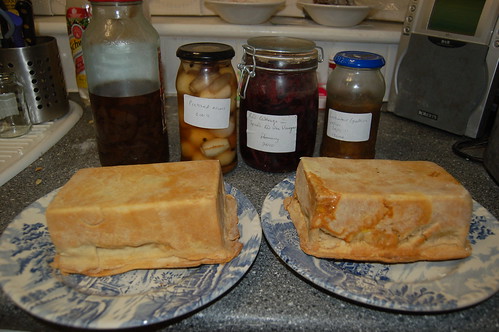
Finding alternatives: fat

Becoming self-sufficient means finding alternatives to basics we would otherwise buy in the supermarket. Honey can, in some circumstances, replace sugar, hence the reason for our purchase of three hives. We have replaced some flour in our diet with potatoes, though we still use some commercially purchased flour. Fats were always going to be a problem. I have, however, stumbled on a source.
I hasten to add, this is not a large source. We swapped some jam for pheasants recently. I cut off the breast meat and then boiled the remaining carcass. The pan was left to stand to cool and I discovered a useful layer of fat on the surface which I scooped off (see photo above). It will be sufficient for roasting the vegetables for the forthcoming Christmas dinner.
Whilst this is only a small quantity, it is likely that we will get more from the ducks we have in our freezer.
Cabbage and mash - for the hens
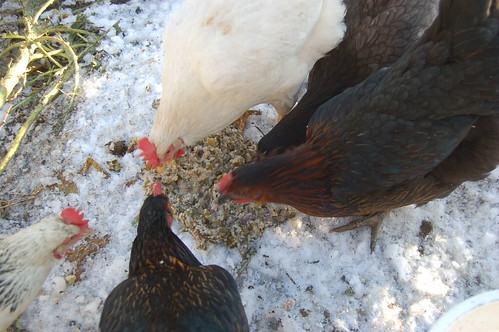
Our hens like their greens! The neighbouring allotment holders leave bags of various greens for us that they have rejected for human consumption. Our hens cheerfully chomp their way through them. There are however some leaves which they find a bit tough, typically large cabbage and sprout leaves. We have discovered that the hens will eat them chopped. We make a mash with oatmeal and then add in the chopped green leaves.
Come the spring, we will be feeding them on grass, dandelions and clover which we found, during the mild autumn growing in abundance near the allotment. This is a free source of food. All we have to do is pick it for them and put it into the chicken run. They will kindly convert these greens into protein for us.
Saturday 17 December 2011
Bee keeping at Bill Quay Community Farm
Bill Quay in Gateshead has a community farm where we help look after the bees on a voluntary basis. There are three hives on the farm and today we went up to give them oxalic acid. This is to keep the varroa mite at bay. Bee colonies have been hit heavily by this parasite in recent years so keeping a vigil against it is important.
Oxalic acid comes mixed into a sugar solution and is dripped into the hive between the frames onto the bees. It turned out to be a much easier task than we anticipated. (This is the first time we have applied it.) Tomorrow we do our own hives.
It strikes me that honey production is something that local communities could do. Here in the UK, we import large amounts of honey. There is clearly a demand for it and it is a healthy addition to the diet. Each community is capable of supporting bee keeping and honey production of some sort. All communities, even urban ones, need bees and other pollinating insect or otherwise our gardens will wither and die. Instead of importing honey from the other side of the planet, knocking up vast food miles in the process, we could produce much more of it in the localities where we live. 200 years ago, when much more of Britain's food was locally produced, hives and honey production was a common sight just about everywhere. Not everything we did in the past needs to be discarded.
Oxalic acid comes mixed into a sugar solution and is dripped into the hive between the frames onto the bees. It turned out to be a much easier task than we anticipated. (This is the first time we have applied it.) Tomorrow we do our own hives.
It strikes me that honey production is something that local communities could do. Here in the UK, we import large amounts of honey. There is clearly a demand for it and it is a healthy addition to the diet. Each community is capable of supporting bee keeping and honey production of some sort. All communities, even urban ones, need bees and other pollinating insect or otherwise our gardens will wither and die. Instead of importing honey from the other side of the planet, knocking up vast food miles in the process, we could produce much more of it in the localities where we live. 200 years ago, when much more of Britain's food was locally produced, hives and honey production was a common sight just about everywhere. Not everything we did in the past needs to be discarded.
Friday 16 December 2011
Preparations for a self-sufficient Christmas feast
I am currently sorting out what we are having for our Xmas dinner. Turkey is off the menu as the meal needs to be predominantly made from our own food sources. Instead, we are having fillets of pheasant and wood pigeon with roast potatoes, roasted Jerusalem artichokes, sage and onion stuffing and broad beans. Starter will be pea and nettle soup. I am making the stock for it now from a pheasant (the same pheasant that has provided the fillets). Desert will be baked apples stuffed with our own sweet mince. I have quite a stash of hazel nuts so I may roast some of them. I'm also thinking of doing a game pie though that's not for Christmas day.
Meanwhile, it is snowing outside. I need to check on the hens shortly and see how they are coping with the weather. They are all young so have not experienced snow before. I'm making some mash for them at the moment and will take that over shortly.
Meanwhile, it is snowing outside. I need to check on the hens shortly and see how they are coping with the weather. They are all young so have not experienced snow before. I'm making some mash for them at the moment and will take that over shortly.
Thursday 15 December 2011
Eggs and jam as an alternative currency
Were the pound to go down in a spectacular burst of flames as a result of an imploding Euro (okay, it's a worst case scenario I admit) it seems as though I have the alternative currency: eggs and jam. I suspect I will be able to add to that list preserves of any kind you can think of and honey. In trying to become self-sufficient, we have realised that there needs to be some degree of trade with other gardeners and allotment holders. We probably won't be able to produce everything we need ourselves, but other locals are producing some of the foods we ourselves haven't grown.
I am an avid preserve maker and I have found there is a ready market for jars of jam, jelly and pickles which can be swapped for cabbages, leeks, sprouts and game. With my hens now laying, eggs as well are great for swapping.
So in recent weeks we have swapped jam, lemon curd and eggs for pheasants and various vegetables. Today one jar of jam and one of marrow chutney got me a bag of vegetables grown on one of the neighbouring allotments.
Next year should be even more interesting. We will be harvesting honey. And plenty of people we know are eager to get their hands on a pot of it.
I am an avid preserve maker and I have found there is a ready market for jars of jam, jelly and pickles which can be swapped for cabbages, leeks, sprouts and game. With my hens now laying, eggs as well are great for swapping.
So in recent weeks we have swapped jam, lemon curd and eggs for pheasants and various vegetables. Today one jar of jam and one of marrow chutney got me a bag of vegetables grown on one of the neighbouring allotments.
Next year should be even more interesting. We will be harvesting honey. And plenty of people we know are eager to get their hands on a pot of it.
Tuesday 13 December 2011
Self-Sufficient in Suburbia - October 2011
This is the latest edition of the programme I present for the Horticultural Channel. It covers October. This year we have had a mild autumn and this has had an impact on our crops and especially the bees. I make a number of jams and chutneys, pickle onions and make flans using the unexpected supply of new nettle leaves and eggs from our own hens.
Monday 12 December 2011
The ups and downs of hen keeping
Yesterday was a day for which we had been waiting for some time. Another of our hens started laying. We think the egg comes from our coral nick - we call her Snow White. Her egg was much lighter in colour, a light beige colour. Our other two hens that are laying produce brown eggs.
Alas, this morning, the news was not so good. We have just experienced our first loss. One of the hens, Gingie, the Columbian blacktail, died. I found her not looking at all happy in the henhouse when I opened it this morning. I brought her back home but she died an hour later. It's odd how attached I have become to each of our 6 hens. Today has therefore not been a happy experience.
I buried her next to the plum tree on the allotment. To cap it all, I managed to smash the one egg that was laid this morning when I cleaned out the henhouse.
Alas, this morning, the news was not so good. We have just experienced our first loss. One of the hens, Gingie, the Columbian blacktail, died. I found her not looking at all happy in the henhouse when I opened it this morning. I brought her back home but she died an hour later. It's odd how attached I have become to each of our 6 hens. Today has therefore not been a happy experience.
I buried her next to the plum tree on the allotment. To cap it all, I managed to smash the one egg that was laid this morning when I cleaned out the henhouse.
Friday 9 December 2011
How to make gooseberry chutney
We had some gooseberries in the freezer but not enough to make the quantity of gooseberry chutney we wanted, so we added marrow and apple to it. The recipe was sent to me by Ben Woodcock whose site is http://www.pickleandpreserve.co.uk/. He picked up the recipe from www.gooseberryrecipes.org. So thanks to Ben for drawing my attention to this recipe. It is simple and easy to make and makes a great chutney.
How to make apple pasties
We have a number of sacks of apples in storage for the coming months. They need to be checked regularly to ensure any that won't survive storage are used up. In this video I use some of the apples to make pasties.
Saturday 26 November 2011
The bees are still buzzing
I popped over to the allotment to check on the hens this morning. Whilst there I had a quick look at the bees. We had gales and rain yesterday but though it is breezy now, the sun has been out a bit. The bees are making full use of it. They were very busy even though it is nearly the end of November. The mild autumn is having some interesting effects. I am hoping this will keep going. I could do with a mild winter to help with the crops (and the bees).
Wednesday 23 November 2011
How to make apple chutney

My autumn surplus of apples was gainfully employed to make this chutney, an easy preserve to make.
You will need:
1.5kg apples (weight after being peeled and cored)
0.5kg onions
0.5kg sultanas
0.75kg light brown sugar
500ml white wine vinegar
1 small root of ginger (grated)
1 tsp all spice
2 cinnamon sticks
half tsp ground cloves
1 tsp peppercorns
1 tbsp mustard seeds
Put all the ingredients into a preserving pan and bring to the boil. Turn down the heat and simmer for a couple of hours, stirring often. It is ready when it has thickened into the consistency of a thick sauce. Remember to remove the cinnamon sticks.
Tuesday 22 November 2011
Corned beef pasties
I really got into making pasties during my two weeks on a wartime diet in August so I am continuing to make them. In this recipe I make corned beef and potato pasties. Very nice!
Sprout leaf, bacon and stilton soup

I created this recipe yesterday and almost made it up as I went along. The reason behind it is that I was given a bag of sprout leaves over the weekend to feed to the chickens. These weren't the outer leaves of sprouts but rather the large leaves that grow out of the stem and are normally thrown onto compost heaps when the sprouts are picked. Since my chickens then decided to turn their beaks up at the sight of a few of these leaves, I gave some thought as to whether or not to put them into the compost bin or turn them into a food source for ourselves. They were, after all, in good shape and are perfectly edible. So I came up with the idea of making them into soup.
I used water that had previously been used to boil vegetables. Most people throw this away. Don't do that! Many of the nutrients are boiled out so throwing away the water means you are throwing away some of the best parts of your cooked veg. Into the water I added some chopped potatoes, some tomatoes, a small garlic, chopped sprout leaves, some vegetable stock powder, a couple of rashers of chopped bacon and a large teaspoonful of marmite. This was then boiled until the potatoes were softened.
I then added about 100g of chopped stilton and reheated the soup for a few minutes. Finally, I blended it before serving it.

Sunday 20 November 2011
Feeding the bees
The mild autumn is having an interesting effect on our bees. They have been much more active and have ventured out of the hives to forage much more than is normal for this time of year. Over the past few weeks we have been feeding them sugar syrup but over the last few days, the bees have been quieter, despite the sunny weather we have had today. So we took the opportunity this afternoon to switch them to their winter feed. It was time to give them fondant.
We had bought a 12.5kg block from the supplier we use in Northumberland so we cut it into 3 blocks and placed one in each hive, on top of the frames. We wait to see how long it is before the fondant is eaten but we will make our first check in 2 weeks. We are volunteer beekeepers at Bill Quay Community Farm in Gateshead and recently we fed the bees there. One of the hives got through their fondant in under a month. That's an indication of how hungry these insects can be. But if people take away their honey, they have to eat something.
We had bought a 12.5kg block from the supplier we use in Northumberland so we cut it into 3 blocks and placed one in each hive, on top of the frames. We wait to see how long it is before the fondant is eaten but we will make our first check in 2 weeks. We are volunteer beekeepers at Bill Quay Community Farm in Gateshead and recently we fed the bees there. One of the hives got through their fondant in under a month. That's an indication of how hungry these insects can be. But if people take away their honey, they have to eat something.
Monday 14 November 2011
Eggceptional welcome home
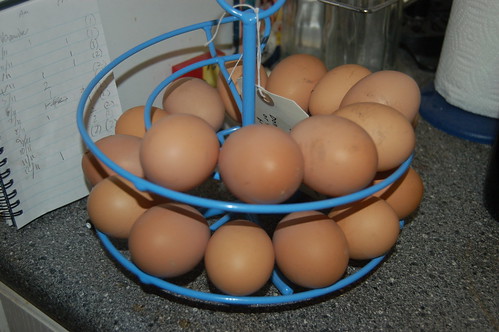
I was in London all of last week and returned home on Saturday evening. And there, waiting for me, was this sight! Lots of eggs laid by 2 of my chickens. The other 4 are still waiting to start their egg-laying career.
I have given half a dozen to a friend who provides us with game (a fair swap). I will be doing more egg cooking soon - and pickling some as well.
Corned beef and potato pie
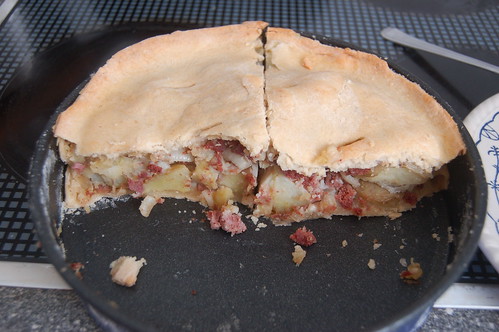
When I spent 2 weeks in the summer on a wartime diet, I acquired a bit of a taste for corned beef which has stayed with me. Okay, so eating corned beef doesn't make me self-sufficient, but the potatoes and onions I put into this pie were grown by us. This pie is made using shortcrust pastry. Quantities of potatoes and corned beef will depend on your taste and outlook. As we are trying to be self-sufficient as possible, we took a leaf out of our wartime cookbooks and used more potatoes than corned beef. One medium sized onion, chopped, went into it as well. Took about 20-25 minutes in the oven at 180C.
Thursday 10 November 2011
Nettle and bacon flan
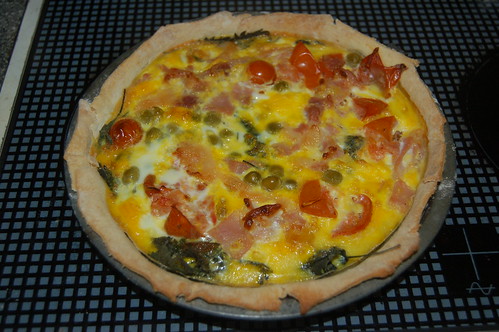
Having picked some nettle leaves recently (the result of our mild autumn making many plants think it is spring) I made this nettle and bacon flan. I used short crust pastry, and into the flan case I put the nettle leaves along with some peas and chopped onions from the allotment and some pieces of bacon. Over them I poured 4 beaten eggs. The recipe is a useful way to use up some of the eggs our hens are now laying.
The flan then went into the oven for 20 minutes. Can be eaten hot or cold.
Wednesday 2 November 2011
Autumn nettle flan making
The mild spell continues into November so we have been making nettle flans using new growth on nettle plants which seem to think it is now spring. The eggs used are from our own chickens.
Tuesday 1 November 2011
How to make sloe jelly
Sloes are not just used to make sloe gin. I use them to make a jelly, combining them with some of the apples I picked at the end of the summer. This is a very pleasant, modestly tart jelly but is easy to make.
Sunday 30 October 2011
Onion planting
We have been up to Dad's allotment today in Marley Hill to plant onions, shallots and garlic. We used the area on bed one where the potatoes had been growing which we harvested last month. Dandelions had taken over. They had taken advantage of the recent mild spell to have a spurt of growth. We dug them out and put them in a bag to ship down to our chicken run. Our hens love dandelions.
We planted a variety of onions called Radar. We bought two pounds of sets a couple of weeks ago. One pound were planted today. The other pound of sets will go onto our own allotment - I rotovated the bed this afternoon ready to plant some time this week.
We planted two varieties of garlic: Early Purple Wight and Bella Italiano. The shallots planted were yellow moon.
These are important crops for us. I am expecting them to be the first out of the ground in the late spring next year, at the end of a lean time for us when many of our stocks of foods will have been used up. Whilst there will be a number of wild leaves we can us then, the onions, garlic and shallots will be welcome additions to our diet.
We planted a variety of onions called Radar. We bought two pounds of sets a couple of weeks ago. One pound were planted today. The other pound of sets will go onto our own allotment - I rotovated the bed this afternoon ready to plant some time this week.
We planted two varieties of garlic: Early Purple Wight and Bella Italiano. The shallots planted were yellow moon.
These are important crops for us. I am expecting them to be the first out of the ground in the late spring next year, at the end of a lean time for us when many of our stocks of foods will have been used up. Whilst there will be a number of wild leaves we can us then, the onions, garlic and shallots will be welcome additions to our diet.
Another 3 hens
We have added to our stock of hens. You may recall that we got three hens in September. Now we have another three. Here they are:
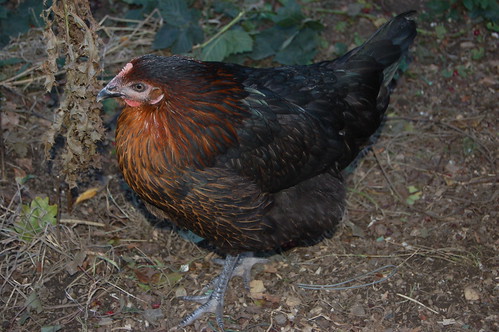
This is Houdini. She's a Copper Black.
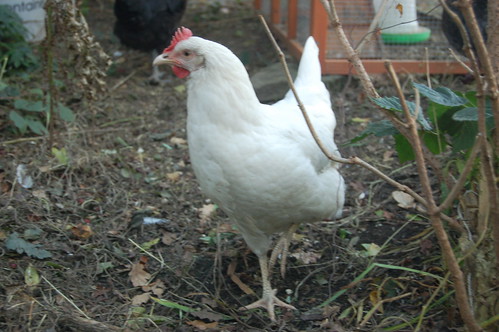
This is Snow White. She is a Coral Nick. Her crest is a bit more developed so we think she may be closer to starting to lay than the other two who came with her.
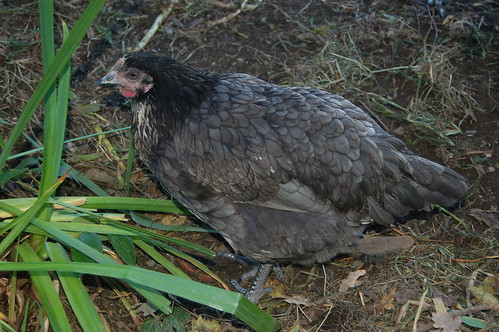
This is Sleepy, a Blue Haze.
At the moment we are still only getting a maximum of two eggs a day. Gingie, our Columbian Black, who we got in September, is still to start laying. We are thinking of waving a roasting tray in her direction in the hope it will encourage her to lay!

This is Houdini. She's a Copper Black.

This is Snow White. She is a Coral Nick. Her crest is a bit more developed so we think she may be closer to starting to lay than the other two who came with her.

This is Sleepy, a Blue Haze.
At the moment we are still only getting a maximum of two eggs a day. Gingie, our Columbian Black, who we got in September, is still to start laying. We are thinking of waving a roasting tray in her direction in the hope it will encourage her to lay!
Thursday 27 October 2011
Signs of spring - in October
The weather this year has been very odd. We started the year with the worst winter for 40 years. The spring was the driest on record for 400 years. The summer was a damp squib. And now, in autumn, the warm spell has resulted in many plants thinking it is spring.
Yellow gorse flowers are a familiar sight in May, not October but I took the following photo just three days ago.
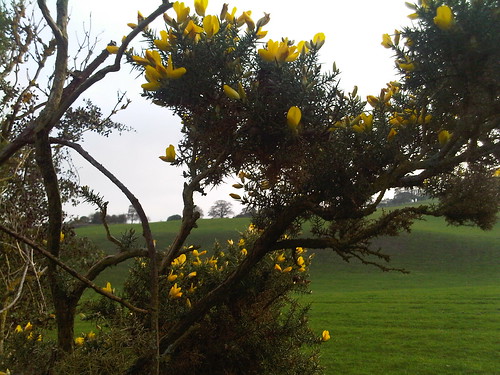
Yarrow flowers in the summer but here it is flowering in Octoer:
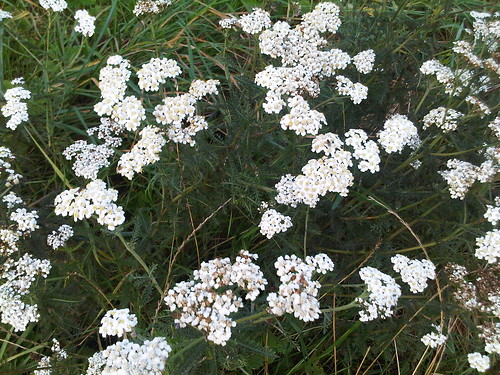
I have also found that nettles, dandelions and other edible weeds are growing. I took a bag with me yesterday to pick the new leaves on the nettles. I steamed them last night and they will go into the freezer shortly. I'm going to pick another batch this afternoon to use in a flan for dinner tonight. We will use our own eggs for this. I've never seen this sort of new growth so late in the year so I'm making the most of it.
In the spring, I make salads from edible wild leaves and flowers. It looks like I'll be able to have an autumn version as well.
One of the other effects of the mild weather is the bees are still active. The hives are still buzzing and the bees seem to be bringing back quite a bit of pollen. That means there are lots of larvae needing to be fed, and that means the queens are still laying. Hive 2 in particular has been very busy. This was the colony we nearly lost a couple of months ago. The queen was missing and had not been replaced by the colony itself. We therefore had to put in a new queen. She is clearly laying. Hopefully, we will have three strong colonies ready to provide us with honey next year.
Yellow gorse flowers are a familiar sight in May, not October but I took the following photo just three days ago.

Yarrow flowers in the summer but here it is flowering in Octoer:

I have also found that nettles, dandelions and other edible weeds are growing. I took a bag with me yesterday to pick the new leaves on the nettles. I steamed them last night and they will go into the freezer shortly. I'm going to pick another batch this afternoon to use in a flan for dinner tonight. We will use our own eggs for this. I've never seen this sort of new growth so late in the year so I'm making the most of it.
In the spring, I make salads from edible wild leaves and flowers. It looks like I'll be able to have an autumn version as well.
One of the other effects of the mild weather is the bees are still active. The hives are still buzzing and the bees seem to be bringing back quite a bit of pollen. That means there are lots of larvae needing to be fed, and that means the queens are still laying. Hive 2 in particular has been very busy. This was the colony we nearly lost a couple of months ago. The queen was missing and had not been replaced by the colony itself. We therefore had to put in a new queen. She is clearly laying. Hopefully, we will have three strong colonies ready to provide us with honey next year.
Tuesday 25 October 2011
Sunflowers and hens
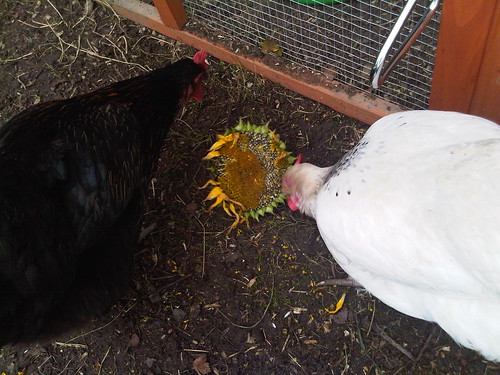
One of the most unexpected wild foods I have found recently was sunflowers. I found them growing next to a public path a couple of weeks ago. I didn't pick any at the time. It seemed a bit early. Yesterday however I decided to revisit the site and see if any were ready for picking. They were. So I picked a bagful and brought them home. They are not for human consumption. They are for the hens.
I took them one flower head yesterday and was disappointed by their lack of interest. When I went back this morning I found it had been picked clean. Success!
Monday 24 October 2011
Egg and chips
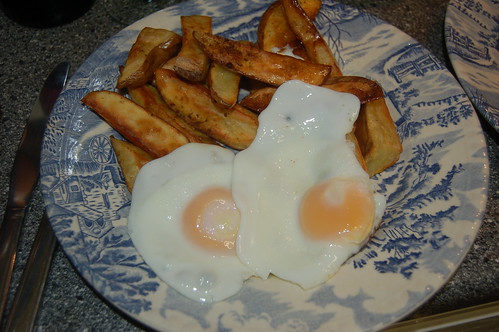
We are still just getting 2 eggs a day (sometimes just one) though we are expecting this to go up once all the hens start laying. Nevertheless, we are getting sufficient eggs to have them on the menu most days. So we have now had our very own self-sufficient egg and chips. We used our own potatoes (cut into chips but roasted) and eggs. Very enjoyable.
Friday 21 October 2011
Local Food Connection
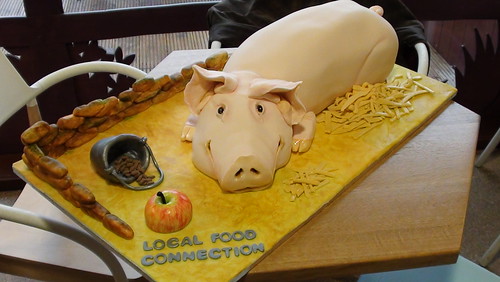
I went to Bill Quay Community Farm in Gateshead this morning for the breakfast launch of Bill Quay Local Food Connection. As a food and social historian and allotment and cookery webcaster, this was clearly going to be of interest to me. The information we were sent explains the project:
Thanks to grant funding from the Big Lottery Local Food Programme, the Farm’s facilities now include a community kitchen, communal eating space and counter for a local food café and farm shop. This distribution and sales hub supports local producers and provides local & regional foods to the community. Along with a programme of inclusive events and activities to engage and educate users the Local Food Connection will offer training experiences and volunteering opportunities for vulnerable adults. Schools and families will be able to use the Connection for educational and recreational purposes.
The Bill Quay Local Food Connection is a new community resource which will make local food accessible, affordable and enjoyable for local people, providing facilities to enable them to taste, buy and cook with local & regional food.
In my opinion, the standardization and mass production of food has led not to a great range of food that a look in a supermarket would suggest is available. Instead, it has led to the loss of local varieties, extra pollution caused by the unnecessary shipping of some foods from thousands of miles away, and an increasing remoteness of food production from the people eating it.
We need to appreciate our food more. That appreciation would increase if we know it is locally produced, rather than churned out of a factory that could be thousands of kilometres away.
So Local Food Connection is getting my full support. I also have a passing interest in Bill Quay Community Farm. I am one of the volunteer beekeepers there. We took some frames of honey off one of the hives a couple of weeks ago. It is now on sale at the farm shop and the proceeds will help support the work of the farm.
Unfortunately we didn't get to try the pig cake, pictured above.
Thursday 20 October 2011
How to pickle onions
We planted onions late on Dad's allotment. The result was that when we picked them recently, they were quite small. They were, however, the right size for pickling. Here's how we pickled ours.
Peel the onions and put in a large bowl. Sprinkle a decent quantity of salt over them and leave for 24 hours, with a tee towel over the bowl. Then rinse the onions and pack them into jars.
To make picking vinegar, put a litre of white wine or cider vinegar into a pan. Add a level tablespoon of black peppercorns, 350g of sugar, a small number of cloves and a sprinkling of powdered mace. Bring to the boil and simmer for one minutes. Then pour into the jars.
Leave the onions for at least 2 weeks before starting to eat them. During that time the vinegar will penetrate the onions.
Tuesday 18 October 2011
Don't wait around to pick the additional growth
The bizarre weather conditions this year have caused some odd growth of some wild foods. In the spring I pick nettles, dandelions and dock. By late summer there are not worth picking. However, I have noticed that there is plenty of new growth of these plants. I suspect this has been caused by the Indian summer we have experienced recently.
I will therefore be going out shortly to pick fresh, green nettle leaves which I will blanch and freeze for winter use. They are a good substitute for spinach. Dock and dandelion are no use for freezing. They are better used as salad leaves.
Don't leave it too long to pick the leaves. A sharp ground frost is expected on Wednesday evening so tomorrow is the best day to do the picking, before Jack Frost gets to work later in the day.
I will therefore be going out shortly to pick fresh, green nettle leaves which I will blanch and freeze for winter use. They are a good substitute for spinach. Dock and dandelion are no use for freezing. They are better used as salad leaves.
Don't leave it too long to pick the leaves. A sharp ground frost is expected on Wednesday evening so tomorrow is the best day to do the picking, before Jack Frost gets to work later in the day.
Monday 17 October 2011
Self-Sufficient in Suburbia - September 2011
This is the latest edition of the programme I make for the Horticultural Channel. It was filmed mainly in September though there were odd bits fromt he end of August and early October.
Tuesday 11 October 2011
How to salt runner beans
We use salting as an alternative to freezing runner beans. This video shows you how to salt them. This is a simple and traditional way of preserving garden produce and is worth a try.
Friday 7 October 2011
How to store onions
There's nothing worse than getting in a good harvest and then finding it's rotted away a few weeks after going into storage. A bit of care avoids this problem. In this video I show you how I store onions, one of our staple crops.
How to make plum chutney
Our plum crop was rather poor this year so we used what was available to make into a chutney. After we made it, we suddenly found we had a glut of plums to deal with as a friend gave us a bag full of them, which we used to make plum and apple jam. Anyway, in this video I show you how to make plum chutney.
Thursday 6 October 2011
Freezing the peas
The pea crop on Dad's allotment was picked recently (we still have to harvest the smaller pea crop from our own allotment). We were very pleased with it as all our previous attempts at growing peas had ended in failure.
Nothing went to waste. The peas were frozen after being blanched for one minute in boiling water. The pea pods were used to make stock and the stalks and leaves were fed to the chickens. Wastenot, want not!
Wednesday 5 October 2011
Hazel picking
Some of you may be aware that I am a local councillor, a role I carry out in addition to my horticultural activities. This afternoon I had a tour of my ward with the leader of Gateshead Council and various officers, as well as my two ward colleagues John and Marilynn. We met them in the car park of the Rose pub, in Streetgate, the next village along from where I live in Sunniside. We were there early and I discovered a hazel tree overhanging the car park. This was too good to miss so John found a carrier bag in his car and whilst he shook the tree, Marilynn and I scurried around like a couple of squirrels collecting the hazel nuts from the ground. We got a good quantity.
After the tour was over, I got out of my suit and into my gardening clothes and headed down the road to Watergate Park where a large number of hazel trees were planted some years ago. A very productive exercise - I gathered a large quantity of hazel. And for good measure, I picked a sack of crab apples in the old Fugar Bar orchard.
If you are into wild food foraging or self-sufficiency, don't leave it any longer to collect the hazel. They are a staple crop for us - high in protein and essential oils. A bit of a super food.
After the tour was over, I got out of my suit and into my gardening clothes and headed down the road to Watergate Park where a large number of hazel trees were planted some years ago. A very productive exercise - I gathered a large quantity of hazel. And for good measure, I picked a sack of crab apples in the old Fugar Bar orchard.
If you are into wild food foraging or self-sufficiency, don't leave it any longer to collect the hazel. They are a staple crop for us - high in protein and essential oils. A bit of a super food.
Thursday 29 September 2011
Recent foraging
August to October are our busiest times for foraging for fruit and nuts. I spent a couple of hours this afternoon picking sloes and will be making a batch of sloe gin and then some sloe jelly over the next couple of days. Yesterday I picked a bucketful of hazel nuts and will be returning for more shortly. And of course there are blackberries, lots and lots of them. I've made bramble jelly (using some crab apples I also picked wild) and bramble butter.
I get the impression that there has been new growth of nettles, dandelions and dock recently. They are what I would normally associate with food foraging in spring. I may do some wild leaf salads soon.
Also due to be picked soon are hawberries. I'll be using them to make jelly. It looks like a bumper crop and the berries are quite fat so they may be good for making ketchup as well.
I get the impression that there has been new growth of nettles, dandelions and dock recently. They are what I would normally associate with food foraging in spring. I may do some wild leaf salads soon.
Also due to be picked soon are hawberries. I'll be using them to make jelly. It looks like a bumper crop and the berries are quite fat so they may be good for making ketchup as well.
Eggciting egg moments
We have had the chickens for nearly a month and I thought I would show you a small number of photos from the most eggciting moments.

Our first egg. Attila started laying the day after we got the chickens. We had to wait nearly 4 weeks for one of the others to start laying.

This is an eggcelent piece of eggquipment. We can keep and use the eggs in the order they are laid.
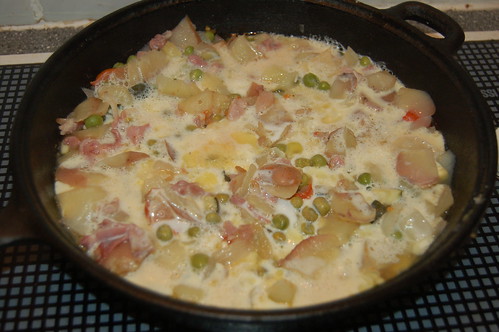
Our first meal with eggs laid on the allotment - an omelette. The potatoes and onions were from the allotment as well. The peas came from a supermarket (but we have now picked our own and won't need to buy any ready frozen produce). The bacon was bought in. We haven't yet got to the point where we are keeping our own pigs!

Our first egg. Attila started laying the day after we got the chickens. We had to wait nearly 4 weeks for one of the others to start laying.

This is an eggcelent piece of eggquipment. We can keep and use the eggs in the order they are laid.

Our first meal with eggs laid on the allotment - an omelette. The potatoes and onions were from the allotment as well. The peas came from a supermarket (but we have now picked our own and won't need to buy any ready frozen produce). The bacon was bought in. We haven't yet got to the point where we are keeping our own pigs!
Wednesday 28 September 2011
Peas harvested
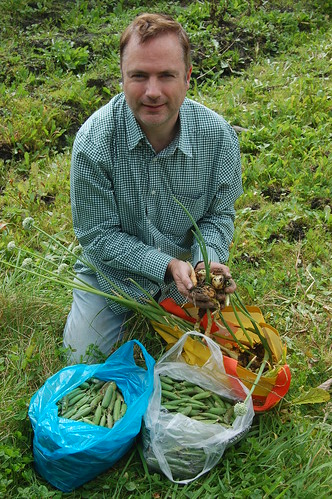
Over the weekend we picked the pea crop on Dad's allotment. We were very pleased with it. We have a second crop to pick on our own allotment but that one is more disappointing. I suspect the wood pigeons may have got many of the seedlings there.
The peas are now frozen. One of these days I will learn to dry them instead. Perhaps a job for next year.
To freeze peas, first shell them and then boil them for about a minute. Drain them and leave to cool before putting into the freezer. Don't throw away the water in which they were boiled. Use it to make pea stock with the pea pods.
In the photo above, I'm holding some of the onions I also harvested on Dad's allotment over the weekend. They will be pickled soon.
Below, shelling peas is a good job to do whilst watching tv.

Our first meal using peas from the allotment: roast duck, roast potatoes and peas.
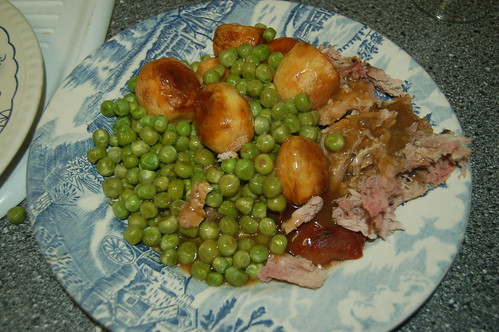
Second hen starts laying
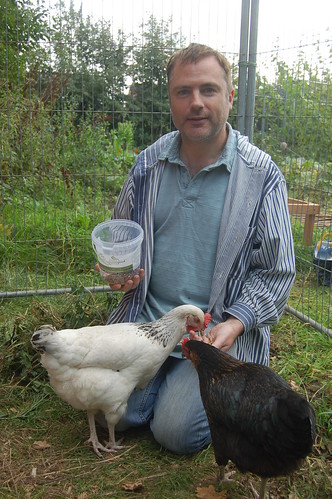
Another eggciting day for us. Another of our hens has started laying. That means 2 of the 3 are now earning their keep. In the photo above are Attila (the light sussex) and Kylie (the rhode rock). Attila started laying the day after we got her at the start of this month. I suspect Kylie is the one starting to lay today. Gingie, out 3rd hen, is out of shot.
The hens seem happy with the new chicken run we built them over the weekend. We have room for another 3 hens in the henhouse and run so soon we will be getting more. Watch this space.
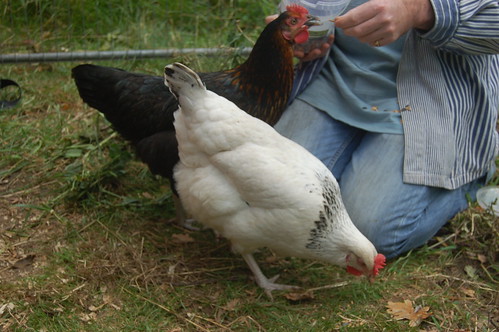
Sunday 25 September 2011
The chicken run is now built
My chickens - Attila, Kylie and Gingie, love their new chicken run which we built today. The hen house, which we bought from Durham Hens, can house 6 when there is a decent size chicken run to go with it or 3 when only using the coop that is part of the hen house. Now that we have the chicken run, we will be able to get 3 more chickens. Our hens took a great interest in scraping the ground and eating bugs, slugs and insects. Useful that they turn insect protein into egg protein we can use.
Also done today - crap apples picked, floors of the hives changed, cucumber and gherkin relish started, pan on cooker now boiling blackberries and crab apples to make bramble jelly. All in all, a productive day.
Also done today - crap apples picked, floors of the hives changed, cucumber and gherkin relish started, pan on cooker now boiling blackberries and crab apples to make bramble jelly. All in all, a productive day.
Thursday 22 September 2011
Blackberry picking
Last week I picked 2 bucketfuls of blackberries last week and a half bucket this afternoon. Plans coming up for their use include making bramble jelly (need to get the crab apples for that), ketchup, vodka, crumbles, pies and jam. So lots coming up.
New queen installed
I have been away for a few days but David was home to deal with the bee hive that needed a new queen. We got one from another beekeeper in the Tyne Valley who was combining two colonies into one, leaving one queen surplus to requirement. She was added to our colony on Sunday in a small box with 4 worker bees from the old colony. The entrance to the box was blocked up with fondant. She had to eat her way out - and during the couple of days she took to eat her escape route, the rest of the colony was able to get use to her smell and feremones. David checked on the hive this evening whilst I was out picking blackberries and hazel nuts. She had eaten her way out and was somewhere in the hive.
We will need to leave it for about 10 days or so before we open the hive again and then we will have to check to see if she is laying eggs. Good news if she is, bad news if she isn't.
We will need to leave it for about 10 days or so before we open the hive again and then we will have to check to see if she is laying eggs. Good news if she is, bad news if she isn't.
Friday 16 September 2011
A lost queen
As beginnings go, this doesn't count as a good one. Hive 2 has lost her queen. We don't know what happened to her and it appears that the colony has not replaced her. The hive has lots of honey in it but no brood. Our friend John looked at the hive yesterday. He's an experienced beekeeper and this was the 2nd time he has looked at our hives. He confirmed our fears.
Life however is full of coincidences. We had an email on Tuesday from Mark and Kym - on whose beekeeping course we went last year - asking if we needed a queen as they had one going spare. They are joining up a weak colony to a strong one and didn't wat to kill off one of the queens. So, on Sunday, David will go to Northumberland to pick up the queen and hopefully, if she makes herself at home in hive 2, the colony will be saved.
I'll be away over the weekend so I'll be missing the fun.
Life however is full of coincidences. We had an email on Tuesday from Mark and Kym - on whose beekeeping course we went last year - asking if we needed a queen as they had one going spare. They are joining up a weak colony to a strong one and didn't wat to kill off one of the queens. So, on Sunday, David will go to Northumberland to pick up the queen and hopefully, if she makes herself at home in hive 2, the colony will be saved.
I'll be away over the weekend so I'll be missing the fun.
Thursday 8 September 2011
The hens have arrived
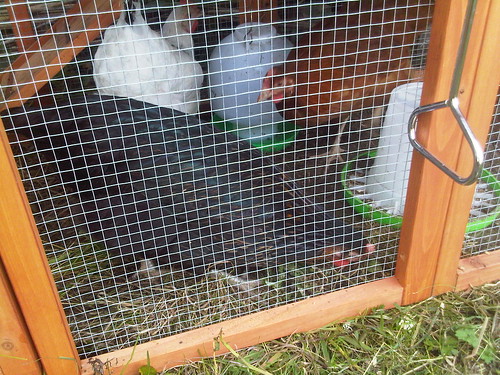
I am delighted to be able to announce that we are now the proud owners of three chickens called Attila, Kylie and Gingie. One of them (Attila) has already laid 5 eggs for us. The other two are point of lay so hopefully they will be producing eggs for us shortly.
Attila (the hen) is a Light Sussex, Kylie (colourful feathers) is a Rhode Rock and Gingie (ginger colour) is a Columbiam Blacktail.
They are settling in to their hen house (we got them Friday last week) but we are going to build them a much bigger chicken run which will allow us to get a few more chickens as well.
How to make raspberry chutney
I normally use raspberries for jam making but the soft fruit crop has been so good this year that I had some raspberries left over to make a chutney. Here's the recipe:
1kg raspberries
1kg peeled and cored apples
4 cloves of garlic
50g grated fresh ginger root
1 teaspoon mustard powder
1 teaspoon salt
pinch of cayenne pepper
500ml cider vinegar
200g brown sugar
Put the raspberries and the chopped apples into the jam pan with the ginger, crushed garlic, mustard, salt and cayenne pepper and mix well.
Add the vinegar and apply heat to bring it to the boil. Simmer for five minutes and then add the sugar. Mix well and simmer for at least 45 minutes, until the mix has thickened. Then add to warm, sterilised jars.
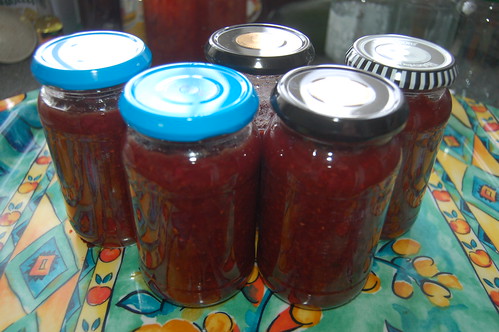
Friday 2 September 2011
How to store potatoes
We have now started harvesting our potatoes though most are still to come in. Storing them correctly is vital if we are to ensure they last into next year. In this video I show you how we prepare them for storage. I had an interesting comment from a Latvian viewer who recommended laying the potatoes out on newspapers in a dry location to let any soil on them dry out. The soil drops off easily. Certainly more time effective if the crop is very large though it leaves the problem of potatoes with slugs or bugs in them not being sifted out.
We took the decision at the start of the year that potatoes will be by far our biggest crop as we will be using them as a partial substitute for wheat flour. Now that the crop is starting to come in, watch this space for some new posts on cooking with spuds!
Building the polytunnel
The polytunnel has been in place for a couple of months on the allotment. We filmed this when we built it and then filmed the final scene just over a week ago to give an idea of what the polytunnel is like when it's in use.
Friday 26 August 2011
Self-Sufficient in Suburbia - June 2011
This is the next edition of Self-Sufficient in Suburbia covering June. We are building a poly tunnel, digging a pond, handling bees, cooking in the kitchen and helping Dad with his allotment.
Hazel nuts in abundance
The growing season is earlier in London and the South East than it is in the North East. As I walk around the local woods next to our village of Sunniside in Gateshead checking out the wild food supplies, I have noticed that hazel is in great abundance. My guess is that it will be a bumper crop. I came down to London a few days ago and have found lots and lots of hazel nuts ready for picking. Indeed, we did pick some and have spent the morning cracking them open and eating them. It's a few weeks yet before hazel nuts will be ready for picking back home but start looking around your local hedgerows, parks and woodlands for them. They are high in protein and oils and are an important part of the self-sufficient diet.
Thursday 18 August 2011
Wartime cooking - marrow stuffed with spam
This was the last of our meals on our 2 week wartime diet. A wartime experience cannot be complete without spam. This recipe - marrow stuffed with spam - also highlights the importance of allotments in feeding the nation during the Second World War. It also helps to highlight how allotments can play a role in feeding Britain in the 21st century, were we to stop them being used for house building or illegitimate car repair businesses.
The soft flesh was scooped out of the marrow after I sliced them down the middle. The stuffing was made from chopped spam (a quarter of a tin), a chopped onion, a bit of corned beef that we hadn't used up and, of course, the great wartime ingredient, breadcrumbs. I added a little bit of lard. Normally not somethig I use, it was the main cooking oil of the Second World War in Britain. As a special treat, we used an ounce of cheese, grated over the top. Given that a person's ration of cheese was 2oz a week, this amounted to an incredibly luxurious meal.
Put in the over at 180C.
We've stuffed marrows before though this is the first time we've used spam as the protein. We rather like stuffed marrows and with the crop we have growing on the allotment, we'll be having more of them over the coming weeks.
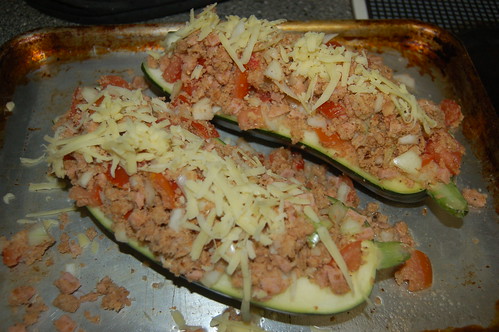
Marrow before cooking
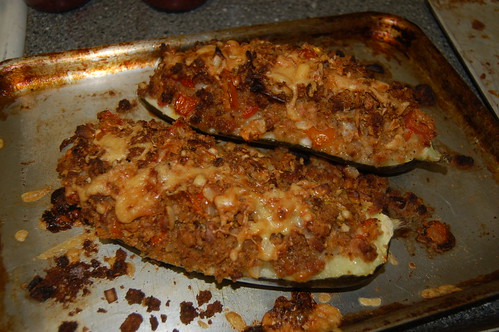
Marrow after baking
Leftovers soup
One of the great lessons from the wartime diet that is useful for those of us setting out to be self-sufficient is waste - or rather lack of it. Nothing is wasted. Food leftovers are not destined for the bin or the compost heap. They are the ingredients for another meal. In this video I put together a load of leftovers and make leftovers soup. Rather tasty as well.
Rabbit burgers
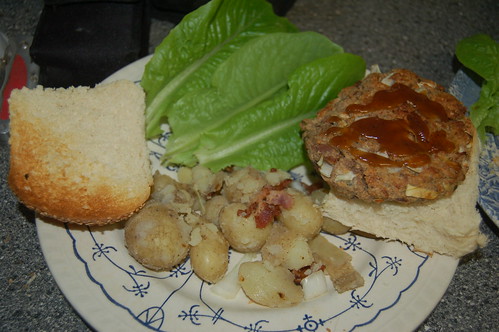
We had some rabbit meat left over from our wartime cooking so we decided to use it to make rabbit burgers. This had the attraction of letting us use up some sausage meat leftover from some other wartime cooking (the potato piglets).
The rabbit was chopped and mixed with the sausage meat, some bread crumbs and some soya flour. There was already some herbs in the sausage meat but I added a chopped onion as well (we picked the main onion crop yesterday).
The burgers were grilled rather than fried. And we had them in a couple of toasted buns. Alas, the buns came from a shop. I haven't had time recently to make bread so I am surviving on the muck that is sold in shops. A few lettuce leaves and a potato salad (we have started harvesting the potatoes) and a splash of homemade hawberry ketchup and the meal was complete.
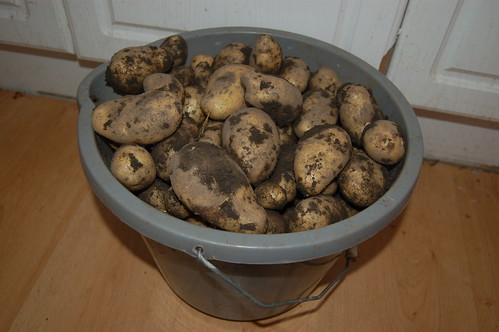
The first potatoes harvested from the allotment.
Wednesday 17 August 2011
Wartime curried rabbit
As part of our wartime diet experience we launched a counterattack on the army of rabbits that takes such a toll on my brassicas. I found a recipe in a 1940 cookbook for curried rabbit. The quantity of curry powder used was tiny (half a teaspoon) for the whole rabbit so this was more a hint of curry than something we, in the early 21st century, would regard as an actual curry. I also suspect that modern food is so packed full of added flavourings and enhancers that our taste buds are shot to bits. I could barely taste the curry in the rabbit. Nevertheless, it was fun to try.
Rabbit was not part of the meat ration so if you got one, it was in addition to your basic meat allowance. Having spoken to many people who lived through the period, though the price of rabbit was controlled by the government, in rural areas in particular, rabbit was often traded for other foods. Across Britain, many people kept rabbits in hutches in their back gardens. They often joined together to form rabbit clubs to share experience, information, feed and time to produce rabbits for the pot.
Monday 15 August 2011
Wartime potato crisps
These are nothing like the crisps that are consumed nowadays. Instead, this is another wartime recipe that used up a kitchen waste - potato peelings - that would otherwise be thrown out. Potato skins are the most nutritious part of this vegetable so it is useful to find ways of using peelings regardless of whether we are at war or not.
To make wartime potato crisps, dry off the peelings (make sure the potatoes are scrubbed before peeling them). Put a bit of oil onto a baking tray and put it in an oven at 200C. To make this more realistic of the time, we used lard but a small amount is all that is needed - enough to give a thin layer over the bottom of the tray.
When the oil or lard is hot, scatter the peelings over the tray and then sprinkle some herbs or curry powder over them. Return the tray to the oven and roast for up to 15 minutes. They should come out crisp and tasty. We are definitely making these again.
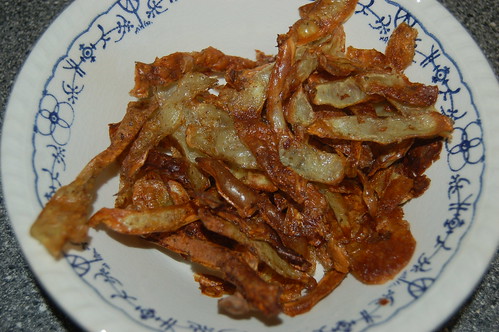
Wartime cooking - bangers and mash
Our plan had been to have toad in the hole to see how people coped with different ingredients to those normally used. We were able to make the sausages but the batter was a disaster. Fortunately I tested the batter before using up our precious sausages. I used whole meal instead of plain white flour (which was not available for much of the war) and I used powdered egg (or rather, a modern day powdered substitute). If people made toad in the hole during the war, I'm at a loss as to how they made an edible meal. Instead, we decided to have bangers and mash.
We decided to opt to relive the diet of 1942, perhaps the most extreme of the war years when meat shortages in particular were attheir worst (though they got worse still in 1946-8.) So sausage meat was part of the meat ration (it was on rations 1942-4). We had to make sure the sausage meat stretched to cover a number of meals. To ensure we could do this we did what they did during the war - added additional ingredients. Most of the extra bulk came from bread crumbs - a great way to use up stale bread. Since most of our wheat continued to be imported, everyone was under immense pressure to avoid wasting bread. It may have been off the ration, but anyone caught feeding bread to ducks in the local park was liable to prosecution.
Also added into the sausage meat was one of our precious onions - again showing that having the allotment was a great bonus when it came to additional food and getting into our diet foods which were difficult to get at the shops. We also added a bit of lard though we had to ensure it was used sparingly as cooking fats were rationed. The final ingredient was soya flour. This is high in protein but had to be imported. As a food concentrate it took up only limited shipping space. It was an important addition to various foods. If you bought wartime sausages, (as opposed to sausage meat) they would almost certainly contain much more breadcrumbs than meat so soya flour was added to them to improve their protein content.
Once all the ingredients are mixed together, shape them into sausages and try them skinless (skins were difficult to get during the war).
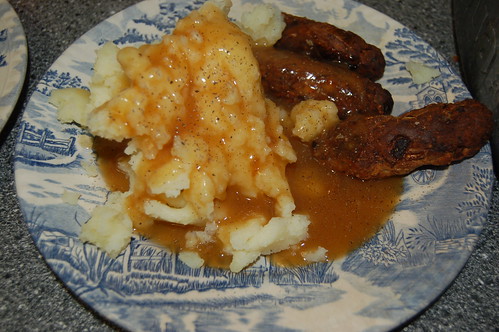
Wartime cooking - potato piglets
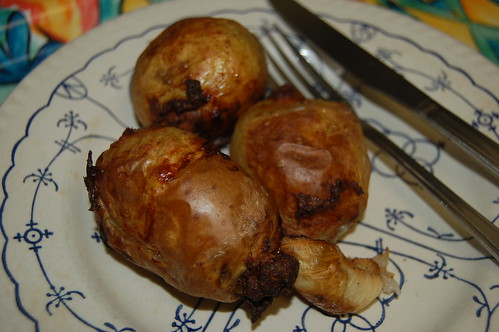
Sausage meat was rationed from 1942-44. Even when it was not on the ration, care needed to be taken to stretch out the sausage meet over a number of meals. I came across this recipe for potato piglets in a cook book published by Durham County Council in 1940. It is simple and easy to do.
The only bit we have changed from the original recipe is to add some herbs to the sausage meat.
Make a hole right through a potato and fill it with sausage meat. Then bake in a hot oven until the potato and sausage are cooked right through. Serve hot.
Wartime cooking - mock orange marmalade
Some foods that were common before the war were either very difficult or impossible to get during the war. Oranges were available during the war but only in small numbers and the ones that were sold in the shops were normally reerved for children. Yet orange marmalade had been a staple of the British breakfast table. How was Britain to cope without her favourite preserve.
The answer was to make a mock orange marmalade. It contains no orange at all but is made instead from apples and carrots! Here's how to make it:
Chop a handful of apples and put them in the jam pan. Cover with water and bring to the boil. Leave simmering for 2 hours.
Strain the resulting pulp through a jelly bag and measure the liquid. Put this into a pan and add in two grated carrots and two teaspoons of orange flavouring. Bring to the boil.
At this point you need to add sugar. Wartime preserves had far less sugar in their jam than nowadays and I suspect the amount I used in this recipe was on the generous side for the war years though 30% less than I use now.
Bring back to the boil and check for the setting point. Once reached, added to sterilised jars.
During the war, your preserve ration was one pound of jam per person every two months. If you gave up your preserve ration, you could get a bit extra sugar to make preserves. Given the meagre preserves ration, making your own instead was a good idea. It was dependent however on having a supply of fresh, locally grown fruit. Most of our fruit was imported before the war and so, from 1939-45, fresh fruit of all types was in short supply (and in some cases such as bananas virtually impossible to get). The Government's efforts to ensure we had our 1940s equivalent of "5 a day" was based on getting us to eat fresh vegetables, especially potatoes and carrots. Britain could be self-sufficient in basic vegetables, even if some, such as onions, had previously been imported.
In this recipe I used wild apples. And picking wild fruit was something that many more people did back in the war years.
By the way, the mock marmalade worked very well.
Tuesday 9 August 2011
How to make raspberry and whitecurrant jam - the video
I made raspberry and whitecurrant jam a few weeks ago so there's the video. And if you don't want to view me making it, here's the recipe:
Equal weight of raspberries and whitecurrants - put them into a jam pan and boil them.
When the fruit has broken down, add sugar - the same weight as total weight of fruit.
Bring back to the boil and keep boiling until the setting point is reach (put a small amount of jam on a plate and if it forms a skin, it's reached the setting point.)
Then add to warmed, sterilised jars.
How to make a Lord Woolton pie - the video
For three days last week, whilst on our wartime diet, we had Lord Woolton vegetable pie for dinner. I rather liked it and we will be adapting it to the 21st century once we have finished reliving the 1940s. (Given what is happening in London at the moment, some people there must feel like they are bing forced to relive the blitz.) Anyway, this is the video of how I made the pie.
Saturday 6 August 2011
How to prepare wood pigeon
We recently traded jam for 19 wood pigeons. This is the first time we have had wood pigeon but I had to learn how to prepare them for use. It turned out to be different to pheasant and duck which I have plucked and gutted in the past.
The only usable part of the wood pigeon is the breast. Instead of plucking the whole bird, pluck along the centre of the breast. Then cut and peel back the skin to reveal the breast meat. Cut the breast fillets off the carcass.
The rest of the bird unfortunately cannot be used for anything (unless anyone can send me information otherwise).
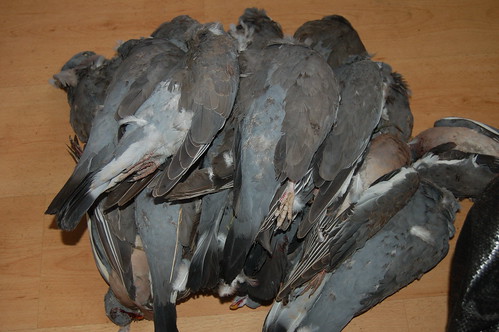
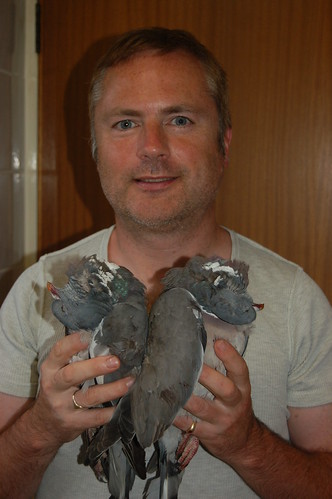
Wartime mint tea
Tea was rationed during the war to 2oz (50g) a week. During our 2 weeks on the wartime diet, we aren't sure the ration will last the course. As a heavy tea drinker, I have had to come up with alternatives. So I am drinking mint tea between meals.
Friday 5 August 2011
Wartime cooking - potato salads
The first of my videos about how we are getting on with our wartime diet. It's lunchtime on day one and already the allotment is proving to be useful.
Thursday 4 August 2011
How to make redcurrant jelly
After a good crop this year of red currants, I made some redcurrant jelly. This is how I made it.
Wartime diet day 3
It is now the end of day 3 of our wartime diet. The Lord Woolton vegetable pie is now finished but we will make it again in the future, after the two weeks of reliving the war are over. Lunch again was bread and marmite.
So far we have not touched our meat rations but tomorrow I will be making toad in the hole, using powdered egg, powdered milk, wholemeal flour and sausages made from a small quantity of sausage meat, bread crumbs, an onion from the allotment and soya flour. The latter was an important ingredient for wartime sausages. It is high in protein but had the extra advantage of being a concentrated food so could therefore be imported without taking up too much shipping space.
So far we have not touched our meat rations but tomorrow I will be making toad in the hole, using powdered egg, powdered milk, wholemeal flour and sausages made from a small quantity of sausage meat, bread crumbs, an onion from the allotment and soya flour. The latter was an important ingredient for wartime sausages. It is high in protein but had the extra advantage of being a concentrated food so could therefore be imported without taking up too much shipping space.
Frog in the pond
Our new pond has a new occupant, a tiny little frog. It's obviously one that was spawned earlier this year. The pond was dug in the late spring so it was too late for frog spawn for this year so it must have come from another pond nearby. We set up the pond to encourage frogs and other bug eating amphibians onto the allotment so we are delighted it is already working. We also have a fully grown frog living in our greenhouse aat the moment. We had one living there last summer as well.
Work on the pond is not yet completed. We need to add more plants, build up one side and tidy up the edging. And we are thinking of adding some fish to eat the mosquito larvae.
Work on the pond is not yet completed. We need to add more plants, build up one side and tidy up the edging. And we are thinking of adding some fish to eat the mosquito larvae.
Wednesday 3 August 2011
The start of our wartime diet: Lord Woolton pie
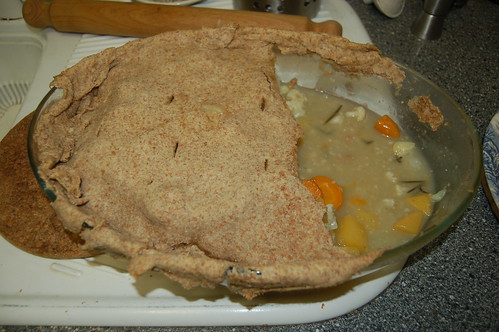
Above and below - Lord Woolton pie

I am now at the end of my 2nd day on a wartime diet. The biggest change I am trying to grasp is the concept of once the ration is used, there's no going to the shops to top up. If something is used up, that's it, there's no more until the next ration period. So everything has to be used very carefully. Meals have to be planned in advance.
This was brought home to me when I made my first wartime recipe yesterday, Lord Woolton pie (named after the Minister of Food). As with so many recipes of the period, it was invented (by the head chef of the Savoy) to use effectively the food resources available to Britain. One of the props of wartime food policy was fresh vegetables. They were produced in the UK therefore avoiding the need to use valuable shipping space to import them.
The jolt to my system was making the pastry. We used 3oz of cooking fat. Our ration was 4oz for a person per week. Fortunately the pie will last both of us for three evening dinners each.
The recipe is:
1lb each of potatoes, carrots, cauliflower and swede. We also added an onion. These were worth their weight in gold. Before the war, most of Britain's onions came from the Continent. Once war was underway, that supply was shut down. Britain therefore had a massive onion shortage. People with allotments could grow onions and many did, helping to supplement the national supply. Our allotment is clearly already working for us on our wartime diet as it was one of our own onions that we used.
Boil the vegetables with a tablespoon of oatmeal and a bit of vegetable stock until the veg has softened. Then add them to a pie dish. Add some herbs (fresh or dry - we used fresh from the allotment) and then top it with wholemeal pastry. White flour was virtually outlawed in 1942 as to make it requires more wheat than is needed to make the same weight of wholemeal flour. And wholemeal is more healthy anyway.
Don't glaze the pastry with milk. It was rationed to 3 pints a week per person so it can't be used for decorative purposes. Bake the pie in the oven for about 25 minutes at 180C.
Lunch over the past two days has been a potato salad. Potatoes were one of the key wartime foods and it is likely that we would have come close to starvation if we were not growing so many ourselves. Growing potatoes produces more calories per unit of land than most other crops so it made sense for Britain to maximise the amount of land used to grow them. Government propaganda of the time also encouraged people to eat potatoes instead of bread.
I can however envisage a time over the next two weeks when I get sick of potatoes unless we have a way of turning them into lots of different dishes. For the two wartime lunches so far we have discovered by accident that having pickle with the potatoes improves the meal. I put pickle in David's lunch yesterday and forgot to add it to mine. When we compared notes we realised the omission.
With the salad today I decided to ignore at least partly government requests to eat potatoes instead of having bread by having both! The reason for this was simple: I was getting short of boiled potatoes. Having taken wartime advice to cut down on use of fuel, I boiled up two days' worth of potatoes on Sunday evening in one go. By lunchtime today, I was running short so I had in addition tot he salad two (small) slices of bread spread with marmite which, helpfully, is not rationed. I also needed something a bit more savory than a simple salad.
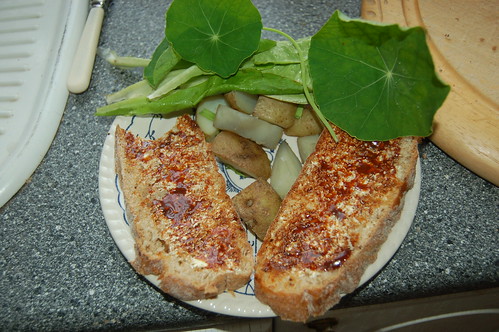
We have now sorted out how we deal with tea. We have 2oz each a week of loose leaf and I was fearing that, as a heavy tea drinker, I would be through it in no time. Through the day I am having a cuppa that consists of mint tea. After a bit of experimentation, we have worked out that for real tea, we need to keep the tea leaves in the pot rather than empty them out and reuse them a bit later. We simply add a bit more tea to the pot (having removed any cold liquid first). At the end of the day, when the tea leaves in the pot have been done to death, we can throw them away (into the compost bin).
I had a shock yesterday when I went to the shops to get some of my rationed goods. We are rationed to 2oz of cheese each per week. Have you seen how small that amount is? The shop didn't even sell it in such small quantities. I had to buy 8oz. That's 2weeks' supply for both of us and it still doesn't look much.
And finally, I am beginning to feel hungry between meals. Our modern day lifestyles mean that if we are peckish and the next meal is not for a couple of hours, we still dip into the biscuit box or the fridge for a snack. My guess is that this snacking is one of the biggest contributors to the obesity epidemic. On our wartime diet, there is no snacking between meal, at least of the fatty food variety. I did snack a few minutes ago but that was to eat a carrot! Nevertheless, I am craving for a chocolate biscuit right now!
Sunday 31 July 2011
How to make blackcurrant vodka
We have had a good blackcurrant crop this year. Most of it went into jam but I did commit to making blackcurrant vodka. Here's the video.
The recipe I use is:
300g sugar
150g blackcurrants
70cl cheap, supermarket own brand vodka
Add the fruit and sugar to a storage jar and pour in the vodka. Close the jar and give it a shake.
Shake the jar once a day until the sugar is dissolved. That can take up to two weeks.
After three months (and occasional shakes) strain the liquid and put into bottles.
Two weeks on a wartime diet
When I set out to be self-sufficient, I quickly realised that important lessons could be learnt from the diet the British experienced during the Second World War. Food was not wasted, people ate healthily, and they ate what they needed. I am keen to apply those lessons to the modern world. As an historian, to understand a period best, I need to do more than just read the sources. I need to live it. So, we are going to do two weeks on a wartime diet, starting tomorrow.
We will have the rations available to people in 1942. Not all food was rationed so we will have modest but realistic supplies of non-rationed foods. Furthermore, people were strongly encouraged and helped to grow food on allotments and in gardens and we will be using some of our own produce. Nevertheless, we are aiming to make this as realistic as possible.
So tomorrow, we will be having bread for breakfast and a potato salad for lunch. For dinner we will be having Lord Woolton pie. More about these in later entries. The wartime Government's food policy aimed to switch people away from white bread, red meat, fats and sugar and on to wholemeal bread, potatoes and fresh vegetables. Hence the reason for the potato salad for lunch. In addition, the Government encouraged people to eat salads during the summer as they were more healthy, used up locally produced food and reduced energy needed to cook meals.
Anyway, I will be doing regular posts on how we get on with this historic diet.
We will have the rations available to people in 1942. Not all food was rationed so we will have modest but realistic supplies of non-rationed foods. Furthermore, people were strongly encouraged and helped to grow food on allotments and in gardens and we will be using some of our own produce. Nevertheless, we are aiming to make this as realistic as possible.
So tomorrow, we will be having bread for breakfast and a potato salad for lunch. For dinner we will be having Lord Woolton pie. More about these in later entries. The wartime Government's food policy aimed to switch people away from white bread, red meat, fats and sugar and on to wholemeal bread, potatoes and fresh vegetables. Hence the reason for the potato salad for lunch. In addition, the Government encouraged people to eat salads during the summer as they were more healthy, used up locally produced food and reduced energy needed to cook meals.
Anyway, I will be doing regular posts on how we get on with this historic diet.
Thursday 14 July 2011
Hive equipment

I am away from home for a few days but David is holding fort back home. He has just sent me a message to tell me more equipment for the bees has arrived. This is a good excuse to post this picture taken on Saturday of David building supers and frames.
I walked past the hives this morning and they looked very busy. Most of the bees seem to be heading to the local woodland. It has a meadow next to it which is full of flowers at the moment. Lots of foraging for bees.
Tuesday 12 July 2011
Picking wild raspberries
We headed off to the local meadow and woodland this evening. Wild raspberries are ready for picking. Within an hour we picked a bucketful. They are destined for use in jam and gin but I want to have a go at making raspberry vinegar. And as I still have loads on the allotment to pick, I'm looking out for a raspberry chutney recipe to try out as well.
Gooseberries galore
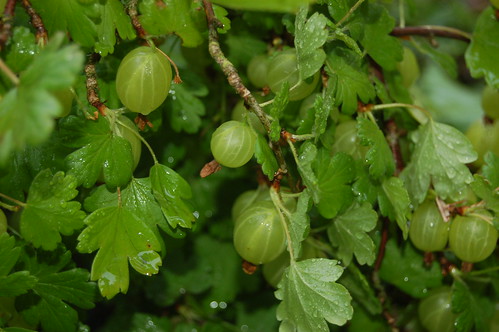
We have gooseberries galore at the moment. So far we have had a large number of crumbles:
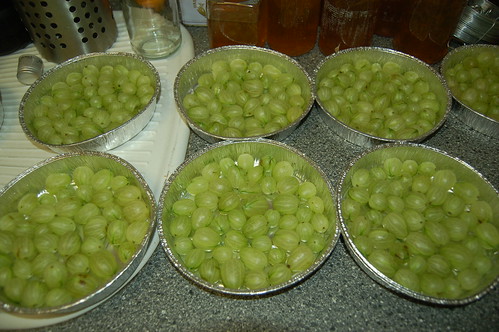
I've also made some gooseberry vodka though I have friends asking me to make some for them, so more will have to be made (it's a hard job but someone has to do it!)
I've also made gooseberry and elderflower jam and summer fruit jam. But what am I going to do with this lot, and what's fruit still to be picked?
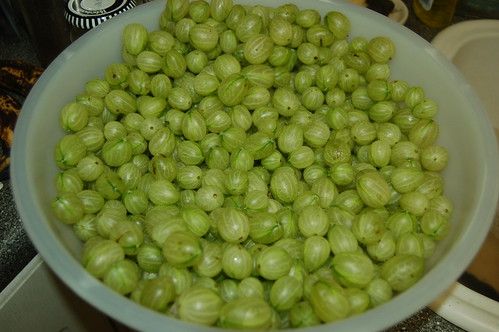
Well, I'm in search of a good gooseberry chutney recipe. So if you have one, feel free to email it to me at jonathanwallace@compuserve.com.
Monday 11 July 2011
Checking the bees
A friend of ours, John, who has kept bees for over 40 years, visited us on Saturday to help us check out our hives. His verdict is that they are all good, strong colonies. We may be pushing it to get a crop of honey this year but he did advise us to put a super on one of the two colonies we got on Sunday last week (the 3rd one we got on Wednesday already has a super on it). David had spent Saturday morning putting supers and frames together so fortuntely we were able to add the super straight away. The first serious honey crop will come next year. I'm really looking forward to getting that in.
Friday 8 July 2011
How to make redcurrant jelly
I picked the redcurrants on Dad's allotment this morning and made redcurrant jelly this evening. Watch out for the video on this. It will be a few days yet before it's edited but I filmed the making of the jelly and as part of the forthcoming Self-Sufficient in Suburbia early summer edition.
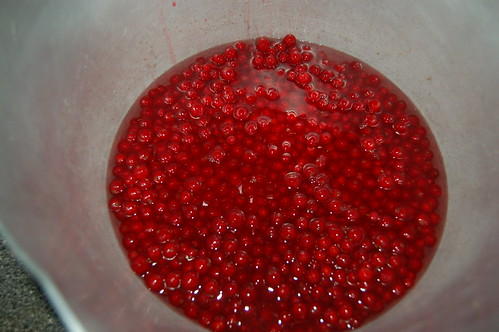
To make the jelly, put the fruit in the jam pan and add some water. Bring to the boil and simmer for about an hour.
Strain the pulp and measure the liquid before putting into into the jam pan again. Apply heat and when it boils, add in 1kg of sugar for each litre of liquid. Reheat to boiling point and test for the setting point. The add to hot, sterilised jars.


To make the jelly, put the fruit in the jam pan and add some water. Bring to the boil and simmer for about an hour.
Strain the pulp and measure the liquid before putting into into the jam pan again. Apply heat and when it boils, add in 1kg of sugar for each litre of liquid. Reheat to boiling point and test for the setting point. The add to hot, sterilised jars.

Blackcurrant jam

We have a fantastic crop of blackcurrants. We have picked all the ones growing on Dad's allotment but are yet to touch the ones in the fruitcage on our allotment. So far we have made blackcurrant jam and blackcurrant vodka.
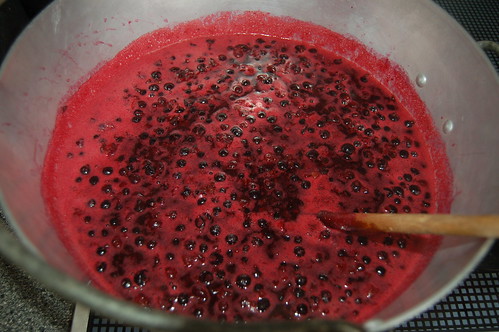

To make blackcurrant jelly, put in a jam pan with a bit of water and boil. Keep simmering until the fruit has fully pulped. Then add sugar - the same weight as of fruit. Bring back to the boil and keep boiling until the setting point is reached (put a spoonful on a plate, allow to cool and if it forms a skin, it is at setting point).
Add to hot, sterilised jars. In this batch we made 18 jars.
More bees
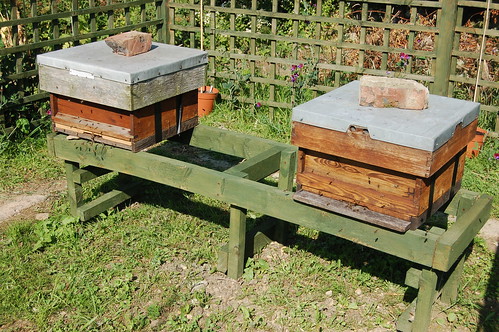
These are the two hives we got on Sunday and below is the one we got on Wednesday.
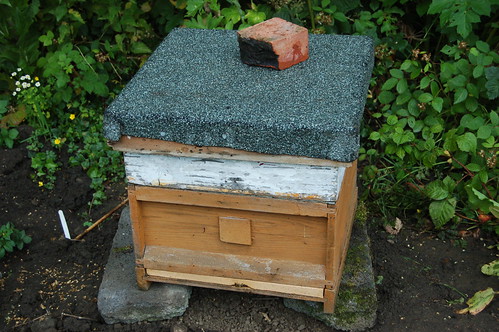
The one we got on Wednesday needs a proper stand which we have on order. We had planned to open the hives over the last couple of days with a friend who is a beekeeper but the weather has been too wet and cold. Tomorrow afternoon is now pencilled in for the next attempt.
There is a possibility we could get some honey this year from the hive we picked up on Wednesday. It came with a super, the box added to the top of the hive from which the queen is excluded. Only the workers can get into it so this is where the honey is stored by the bees. One of the reasons we are keen to check the other hives is to see if they are ready yet to have supers added. Hopefully we will find out tomorrow.
Subscribe to:
Posts (Atom)